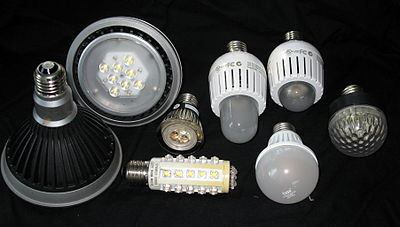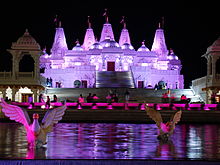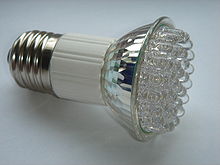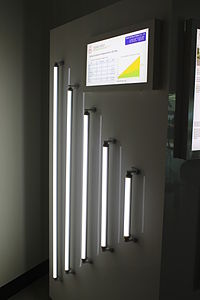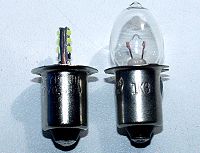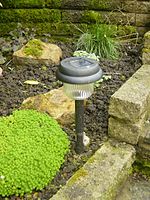- LED lamp
-
An LED lamp (LED light bulb) is a solid-state lamp that uses light-emitting diodes (LEDs) as the source of light. The LEDs involved may be conventional semiconductor light-emitting diodes, organic LEDs (OLED), or polymer light-emitting diodes (PLED) devices, although PLED technologies are not currently commercially available.
Since the light output of individual light-emitting diodes is small compared to incandescent and compact fluorescent lamps, multiple diodes are often used together. In recent years, as diode technology has improved, high power light-emitting diodes with higher lumen output are making it possible to replace other lamps with LED lamps. One high power LED chip used in some commercial LED lights can emit 7,500 lumens for an electrical power consumption of 100 watts. LED lamps can be made interchangeable with other types of lamps.
Diodes use direct current (DC) electrical power; to use them from standard AC power they require internal or external rectifier circuits. LEDs are damaged by operating at high temperatures, so LED lamps typically include heat management elements such as heat sinks and cooling fins. LED lamps offer long service life and high energy efficiency, but initial costs are higher than those of fluorescent and incandescent lamps.
Contents
Technology overview
Dropped ceiling with LED lamps
General-purpose lighting needs white light. LEDs emit light in a very small band of wavelengths, emitting light of a color characteristic of the energy bandgap of the semiconductor material used to make the LED. To emit white light from LEDs requires either mixing light from red, green, and blue LEDs, or using a phosphor to convert some of the light to other colors.
The first method (RGB-LEDs) uses multiple LED chips, each emitting a different wavelength, in close proximity to generate the broad spectrum of white light. The advantage of this method is that the intensity of each LED can be adjusted to "tune" the character of the light emitted. The major disadvantage is high production cost. The character of the light can be changed dynamically by adjusting the power supplied to the different LEDs.
The second method, phosphor converted LEDs (pcLEDs) uses one short wavelength LED (usually blue or ultraviolet) in combination with a phosphor which absorbs a portion of the blue light and emits a broader spectrum of white light. (The mechanism is similar to the way a fluorescent lamp emits white light from a UV-illuminated phosphor.) The major advantage is the low production cost, and high CRI (color rendering index), but the phosphor conversion reduces the efficiency of the device. The character of the light cannot be changed dynamically. The low cost and adequate performance makes it the most widely used technology for general lighting today.
A single LED is a low-voltage solid state device and cannot be directly operated on standard high-voltage AC power without circuitry to control the voltage applied and the current flow through the lamp. In principle a series diode and resistor could be used to control the voltage polarity and to limit the current, but this would be very inefficient since most of the applied power would be dissipated by the resistor. A series string of LEDs would minimize dropped-voltage losses, but one LED failure would extinguish the whole string. Paralleled strings increase reliability by providing redundancy. In practice, three or more strings are usually used. To be useful for illumination a number of LEDs must be placed close together in a lamp to combine their illuminating effects because, as of 2011[update], the largest available LEDs emit only a small fraction of the light of traditional light sources. When using the color-mixing method a uniform color distribution can be difficult to achieve, while the arrangement of white LEDs is not critical for color balance. Further, degradation of different LEDs at various times in a color-mixed lamp can lead to an uneven color output. LED lamps usually consist of clusters of LEDs in a housing with driver electronics, a heat sink, and optics.
Application
LED lamps are used for both general and special-purpose lighting. Where colored light is needed, LEDs naturally emitting many colors are available, with no need for filters. This improves the energy efficiency over a white light source that generates all colors of light then discards some of the visible energy in a filter.
Compared to fluorescent bulbs, introduced at the 1939 World's Fair, advantages claimed for LED light bulbs are that they contain no mercury (unlike a Compact fluorescent lamp or CFL), that they turn on instantly, and that lifetime is unaffected by cycling on and off, so that they are well suited for light fixtures where bulbs are often turned on and off. LED light bulbs are also mechanically robust; most other artificial light sources are fragile.
White-light light-emitting diode lamps have longer life expectancy and higher efficiency (the same light for less electricity) than most other lighting. LED sources are compact, which gives flexibility in designing lighting fixtures and good control over the distribution of light with small reflectors or lenses. Because of the small size of LEDs, control of the spatial distribution of illumination is extremely flexible,[1] and the light output and spatial distribution of a LED array can be controlled with no efficiency loss.
LED lamps have no glass tubes to break, and their internal parts are rigidly supported, making them resistant to vibration and impact. With proper driver electronics design, an LED lamp can be made dimmable over a wide range; there is no minimum current needed to sustain lamp operation.
LEDs using the color-mixing principle can emit a wide range of colors by changing the proportions of light generated in each primary color. This allows full color mixing in lamps with LEDs of different colors.[2] In contrast to other lighting technologies, LED emission tends to be directional (or at least lambertian). This can be either an advantage or a disadvantage, depending on requirements. For applications where non-directional light is required, either a diffuser is used, or multiple individual LED emitters are used to emit in different directions.
Household LED lamps
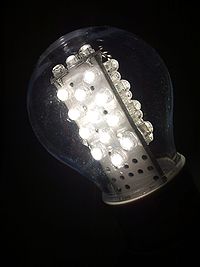 LED Lamp with E27 Edison screw, interchangeable with incandescent lamps
LED Lamp with E27 Edison screw, interchangeable with incandescent lamps
 Top of a Philips 12.5w LED Lamp with E27 Edison screw, interchangeable with 60w incandescent lamps. Watts
Top of a Philips 12.5w LED Lamp with E27 Edison screw, interchangeable with 60w incandescent lamps. Watts
Lamp sizes and bases
LED lamps intended to be interchangeable with incandescent lamps are made in standard light bulb shapes, such as an Edison screw base, an MR16 shape with a bi-pin base, or a GU5.3 (Bipin cap) or GU10 (bayonet socket). LED lamps are made in low voltage (typically 12 V halogen-like) varieties, and as replacements for regular AC (e.g. 120 or 240 V AC) lighting. These lamps include circuitry to rectify the AC power and to convert the voltage to a level usable by the internal LED elements.
LED light bulbs
Many LED lamps have become available as replacements for screw-in incandescent or compact fluorescent light bulbs, ranging from low-power 5–40 watt incandescent bulbs, through conventional replacement bulbs for 60 watt incandescent bulbs (typically requiring about 7 watts of power), and as of 2010[update] a few lamps were available to replace higher wattage bulbs, e.g., a 16-watt LED bulb which is claimed to be as bright as a 150W halogen lamp[3] (A standard general-purpose incandescent bulb emits light at an efficiency of about 14 to 17 lumens/W depending on its size and voltage. According to the European Union standard, an energy-efficient bulb that claims to be the equivalent of a 60W tungsten bulb must have a minimum light output of 806 lumens.[4])
Only some models of LED bulbs are designed to work with dimmers as used for incandescent lamps. LED lamps often have directional light characteristics. The lamps have declined in cost to between US$30 to $50 each as of 2010[update]. These bulbs are more power-efficient than compact fluorescent bulbs[5] and offer lifespans of 30,000 or more hours, reduced if operated at a higher temperature than specified. Incandescent bulbs have a typical life of 1,000 hours, compact fluorescents about 8,000 hours.[citation needed] (One year is 8,760 hours.) The bulbs maintain output light intensity very well over their life-times. Energy Star specifications require the bulbs to typically drop less than 10% after 6000 or more hours of operation, and in the worst case not more than 15%.[6] They are also mercury-free, unlike fluorescent lamps. LED lamps are available with a variety of color properties. The higher purchase cost than other types may be more than offset by savings in energy and maintenance.[7]
Several companies offer LED lamps for general lighting purposes. The technology is improving rapidly and new energy-efficient consumer LED lamps are available.[8]
Specialty uses
White LED lamps have achieved market dominance in applications where high efficiency is important at low power levels. Some of these applications include flashlights, solar-powered garden or walkway lights, and bicycle lights. Monochromatic (colored) LED lamps are now commercially used for traffic signal lamps, where the ability to emit bright monochromatic light is a desired feature, and in strings of holiday lights.
LED lights have also become very popular in gardening and agriculture by 2010. First used by NASA to grow plants in space, LEDs came into use for home and commercial applications for indoor horticulture (aka grow lights). The wavelengths of light emitted from LED lamps have been specifically tailored to supply light in the spectral range needed for chlorophyll absorption in plants, promoting growth while reducing wastage of energy by emitting minimal light at wavelengths that plants do not require. The red and blue wavelengths of the visible light spectrum are used for photosynthesis, so these are the colors almost always used in LED grow light panels. These lights are attractive to indoor growers since they use less power than other types for the same light intensity, need no ballasts, and emit much less heat than HID lamps. The reduction in heat allows time between watering cycles to be extended because the plants transpire less under LED grow lights. Due to this change in growth conditions, users of LEDs are advised not to over-water the plants.
Pioneering mass use
In 2008 Sentry Equipment Corporation in Oconomowoc, Wisconsin, USA, was able to light its new factory interior and exterior almost solely with LEDs. Initial cost was three times more than a traditional mix of incandescent and fluorescent lamps, but the extra cost will be repaid within two years via electricity savings, and the lamps should not need replacing for 20 years.[9] In 2009, the Manapakkam, Chennai office of the Indian IT company iGate spent 3,700,000 Indian rupees (U$80,000) to light 57,000 sq ft (5,300 m2) of office space with LEDs. The firm expects the new lighting to pay for itself fully within 5 years.[10]
 LEDs as Christmas illumination in Viborg, Denmark.
LEDs as Christmas illumination in Viborg, Denmark.
In 2009 the exceptionally big Christmas tree standing in front of the Turku Cathedral in Finland was hung with 710 LED bulbs, each using 2 watts. It has been calculated that these LED lamps will pay for themselves in three and a half years, even though the lights run for only 48 days per year.[11]
In 2009 a new highway (A29) was inaugurated in Aveiro, Portugal, it included the first European public LED based lighting highway[12]
By 2010 mass installations of LED lighting for commercial and public uses were becoming common.
In 2010, on the reconstructed section of Bulevar Kralja Aleksandra (King Aleksandar Boulevard) in Belgrade, Serbia, LED lamps were introduced for new street lighting.[13]
LED lamps have also been used for a number of demonstration projects for outdoor lighting and street lights. The United States Department of Energy has available several reports on the results of many pilot projects for municipal outdoor lighting.[14] Many additional streetlight and municipal outdoor lighting projects have been announced.[15]
Comparison to other lighting technologies
See luminous efficacy for an efficiency chart comparing various technologies.
- Incandescent lamps (light bulbs) generate light by passing electric current through a resistive filament, thereby heating the filament to a very high temperature so that it glows and emits visible light. A broad range of visible frequencies are naturally produced, yielding a "warm" yellow or white color quality. Incandescent light is highly inefficient, as about 98% of the energy input is emitted as heat.[16] A 100 W light bulb emits about 1,700 lumens, about 17 lumens/W. Incandescent lamps are relatively inexpensive to make. The typical lifespan of an AC incandescent lamp is around 1,000 hours.[17] They work well with dimmers. Most older light fixtures are designed for the size and shape of these traditional bulbs.
- Fluorescent lamps (light bulbs) work by passing electricity through mercury vapor, which in turn emits ultraviolet light. The ultraviolet light is then absorbed by a phosphor coating inside the lamp, causing it to glow, or fluoresce. While the heat generated by a fluorescent lamp is much less than its incandescent counterpart, energy is still lost in generating the ultraviolet light and converting this light into visible light. If the lamp breaks, exposure to mercury can occur. Linear fluorescent lamps are typically five to six times the cost of equivalent incandescent lamps but have life spans around 10,000 and 20,000 hours. Lifetime varies from 1,200 hours to 20,000 hours for compact fluorescent lamps. Most fluorescent lamps are not compatible with dimmers. Those with "iron" ballasts flicker at 100 or 120 Hz, and are less efficient.[citation needed] The latest T8-sized triphosphate fluorescent lamps made by Osram, Philips, Crompton and others have a life expectancy greater than 50,000 hours, if coupled with a warm-start electronic ballast. The life expectancy depends on the number of on/off cycles, and is lower if the light is cycled often. The efficiency of these new lamps approaches 100 lumens/W.[citation needed] The efficiency of fluorescent tubes with modern electronic ballasts and compact fluorescents commonly ranges from 50 to 67 lumens/W. Most compact fluorescents rated at 13 W or more with integral electronic ballasts achieve about 60 lumens/W, comparable to the LED bulb.
Research and development
US Department of Energy
In May 2008, the U. S. Department of Energy (DOE) announced details of the Bright Tomorrow Lighting Prize competition. The L Prize is the first government-sponsored technology competition designed to spur lighting producers to develop high quality, high efficiency solid-state lighting products to replace the common light bulb. The competition will award cash prizes, and may also lead to opportunities for federal purchasing agreements, utility programs, and other incentives for winning products.
The Energy Independence and Security Act (EISA) of 2007 authorizes DOE to establish the Bright Tomorrow Lighting Prize competition. The legislation challenges industry to develop replacement technologies for the most commonly used and inefficient products, 60 W incandescent lamps and PAR 38 halogen lamps. The L Prize specifies technical requirements for these two competition categories. Lighting products meeting the competition requirements would use just 17% of the energy used by most incandescent lamps in use today. A future L Prize program announcement will call for developing a new “21st Century Lamp,” as authorized in the legislation.
The EISA legislation establishes basic requirements and prize amounts for each category. The legislation authorizes up to $20 million in cash prizes.[18][19] On September 24, 2009 the DOE announced that Philips Lighting North America was the first to submit lamps in the category to replace the standard 60 W A-19 "Swan/Edison" light bulb. [7] On August 3rd, 2011, DOE awarded the prize in the 60 W replacement category to Philips after 18 months of extensive testing[20]. Commercial availability of the 10 W, 900 lumen lamp was expected by early 2012. The same day, CREE demonstrated a prototype lamp producing 1330 lumens with a mere 8.7 W of input power. [21] While the CREE lamp has not undergone DOE reliability testing and no commercial release date was promised, it is an indication that the "21st Century Lamp" performance levels may soon be within reach of commercial products.
National Institute of Standards and Technology
In June 2008, scientists at the National Institute of Standards and Technology (NIST) announced the first two standards for solid-state lighting in the United States. These standards detail the color specifications of LED lamps and LED light fixtures, and the test methods that producers should use when testing these solid-state lighting products for total light output, energy use, and chromaticity or color quality.
The Illuminating Engineering Society of North America (IESNA) published a documentary standard LM-79, which describes the methods for testing solid-state lighting products for their light output (lumens), energy efficiency (lumens per watt) and chromaticity.
The solid-state lights being studied are intended for general illumination, but white lights used today vary greatly in chromaticity, or specific shade of white. The American National Standards Institute (ANSI) published the standard C78.377-2008, which specifies the recommended color ranges for solid-state lighting products using cool to warm white LEDs with various correlated color temperatures.[22]
DOE launched the Energy Star program for solid-state lighting products in 2008. NIST scientists assisted DOE by providing research, technical details and comments for the Energy Star specifications. Energy Star certification assures consumers that products save energy and are high quality and also serves as an incentive for producers to provide energy-saving products for consumers.
Other venues
Philips Lighting has ceased research on compact fluorescents, and is devoting the bulk of its research and development budget, 5 percent of the company's global lighting revenue, to solid-state lighting.[9]
In January 2009, it was reported that researchers at Cambridge University had developed an LED bulb that costs £2 (about $3 U.S.), is 12 times as energy efficient as a tungsten bulb, and lasts for 100,000 hours.[23]
Remaining problems
The production process of white LEDs is complex and many aspects have room for improvement. This means that the production price of volume products is still relatively high compared to traditional light sources. The process used to deposit the active semiconductor layers of the LED is constantly improved to increase yields and production throughput. The phosphors, which are needed for their ability to emit a broader wavelength spectrum of light, problems tuning the absorption and emission, and inflexibility of form have been issues[citation needed].
More apparent to the end user, however, is the color rendering index (CRI) of low quality LEDs. CRI measures a light source's ability to render colors, with 100 being the maximum. LEDs with CRI below 75 are not recommended use in indoor lighting.[24] Better CRI LEDs are more expensive, and more research and development is needed to reduce costs.
Variations of CCT (color correlated temperature) at different viewing angles present another obstacle against widespread use of white LED. It has been shown that CCT variations can exceed 500 K[citation needed]. This is clearly noticeable by human observers, who normally can distinguish CCT differences of 50 to 100 K in the range from 2000 K to 6000 K, which is the range of CCT variations of daylight.
LEDs also have limited temperature tolerance and falling efficiency as component temperature rises. This limits the total LED power that can practically be fitted into lamps that physically replace existing filament and compact fluorescent types. Much research and development is invested in improving thermal traits. Thermal management of high-power LEDs is a significant factor in design of solid state lighting equipment.
The long life of solid-state lighting products, expected to be about 50 times the most common incandescent bulbs, poses a problem for bulb makers, whose current customers buy frequent replacements.[9]
Some critics assert that producers may over-represent the efficiency and traits of their products to sell into a rapidly growing marketplace, suggesting that consumers still need to be wary of claims made about products in this market.[25]
Applications
- Automotive lighting
- Bicycle lighting
- Billboard displays
- Display lighting in art galleries to reduce heating on works to low values
- Domestic lighting
- Emergency lighting
- Flashlight (Electric torches)
- Floodlighting of buildings
- Grow lights for plants
- Public transit vehicle route and destination signs
- Railway signals
- Stage lighting
- Traffic lights
- Train lights
See also
- Color temperature
- LED
- List of emerging technologies
- List of light sources
- Luminous flux
- Lux
- Photometry (optics) Main Photometry/Radiometry article - explains technical terms
- Radiation angle
- Solar lamp
- Spectrometer
- Street light
References
- ^ Ivan Moreno, Maximino Avendaño-Alejo, and Rumen I. Tzonchev (2006). "Designing light-emitting diode arrays for uniform near-field irradiance". Applied Optics 45 (10): 2265–2272. doi:10.1364/AO.45.002265. PMID 16607994. http://fisica.uaz.edu.mx/~imoreno/Publicaciones/ApplOpt2006.pdf.
- ^ Ivan Moreno, Ulises Contreras (2007). "Color distribution from multicolor LED arrays". Optics Express 15 (6): 3607–18. doi:10.1364/OE.15.003607. PMID 19532605.
- ^ Commercially available 150W Halogen Equivalent PAR38 (240V)
- ^ Lonsdale, Sarah (July 7, 2010). "Green property: energy-efficient bulbs". The Daily Telegraph (London). http://www.telegraph.co.uk/property/greenproperty/7873021/Green-property-energy-efficient-bulbs.html. Retrieved June 8, 2011.
- ^ Elisabeth Rosenthal and Felicity Barringer, "Green Promise Seen in Switch to LED Lighting," New York Times, May 29, 2009
- ^ "Integral LED Lamps Criteria Development". http://www.energystar.gov/ia/partners/manuf_res/downloads/IntegralLampsFINAL.pdf.
- ^ a b Taub, Eric; leora Broydo Vestel (2009-09-24). "Build a Better Bulb for a $10 Million Prize". New York Times. http://www.nytimes.com/2009/09/25/technology/25bulb.html. Retrieved 2010-02-06.
- ^ Eric A. Taub, "LED Bulbs for the Home Near the Marketplace," The New York Times, May 16, 2010; see also the Matthew L. Wald, New York Times Green Blog, An LED That Mimics an Old Standby, June 24, 2010,
- ^ a b c Fans of L.E.D.'s Say This Bulb's Time Has Come By Eric A. Taub. Published: July 28, 2008 - NY Times
- ^ Led'ing the way, Nitya Varadarajan, October 5, 2009
- ^ http://www.hs.fi/kotimaa/artikkeli/Maan+ykk%C3%B6skuusi+Turussa+siirtyy+led-aikaan/1135250879940
- ^ New highway connecting Lisbon to Oporto includes first European LED based lighting in a highway, Aveiro September 11, 2009
- ^ New LED street lights in Belgrade, Beobuild June 16, 2010
- ^ U. S. Department of Energy, Solid-State Lighting GATEWAY Demonstration Results (accessed 16 July 2010)
- ^ for example, Seattle: "Seattle Picked to Lead National Effort on LED Street Lights" (accessed July 16, 2010); Scottsdale: "LED Streetlight Installation" (accessed July 16, 2010); Ann Arbor: LED street lights (accessed July 16, 2010)
- ^ Keefe, T.J. (2007). "The Nature of Light". http://www.ccri.edu/physics/keefe/light.htm. Retrieved 2009-09-10.
- ^ A Short History of Electric Light, The Incandescent Lamp, 1900 to 1920
- ^ Progress Alerts - 2010, US Department of Energy
- ^ Transforming the Lighting Landscape
- ^ http://energy.gov/articles/department-energy-announces-philips-lighting-north-america-winner-l-prize-competition
- ^ http://www.cree.com/press/press_detail.asp?i=1312203835951
- ^ American National Standard for Specifications for the Chromaticity of Solid-State Lighting (SSL) Products
- ^ Great bright hope to end battle of the light bulbs, The Daily Mail, January 29, 2009
- ^ ENERGY STAR Program Requirements for Solid State Lighting Luminaires
- ^ Justin Maeers, LED misrepresentations, May 2010
Further reading
- Light Emitting Diodes, Second edition by E. F. Schubert (Cambridge University Press, 2006) ISBN 0-521-86538-7
External links
- e-lumen.eu – a website from the European Commission about the second generation of energy-saving lightbulbs
- Notes on LEDs, gizmology.net
- U. S. Department of Energy, Using Light Emitting Diodes
- U. S. Department of Energy, Solid-State Lighting GATEWAY Demonstration Results
- Detailed spectra plots, of hundreds of LEDs etc, ledmuseum.home.att.net
- Efficient LED lighting in conjunction with low-voltage domestic solar PV and mains, earth.org.uk
- "Fans of L.E.D.'s Say This Bulb's Time Has Come" New York Times, July 28, 2008
Lamps and lighting Incandescent Fluorescent High-intensity
discharge (HID)Mercury-vapor · Hydrargyrum medium-arc iodide (HMI) · Hydrargyrum quartz iodide (HQI) · Metal halide (Ceramic) · Sodium vaporGas discharge Deuterium arc · Neon · Sulfur · Xenon arc / Xenon flash · Black light · Tanning lamp · Germicidal · Growth lightElectric arc Combustion Other Lamp (electrical component) · Light fixture · Lightbulb sockets · Light-emitting diode (LED) · LED lamp · Solid-state (SSL) · Plasma · Electroluminescent wire · Chemiluminescence · Radioluminescence · Glow stick · ESLCategories:- Lamps
- Semiconductor devices
- Energy-saving lighting
- Light-emitting diodes
Wikimedia Foundation. 2010.

